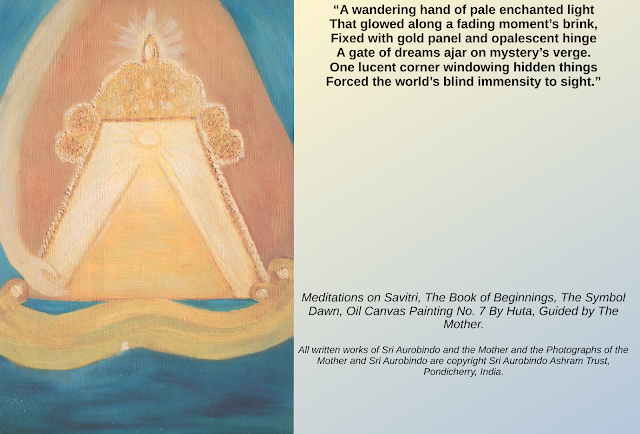A synthesis of Savitri and Theosophy - Painting No 7
Why a theosophical meditation on Savitri provides a wonderful example of synthesis of philosophy with art ? In his own letter Sri Aurobindo, a synthesiser writes -
"This is the real stumbling-block of mystic poetry and specially mystic poetry of this kind. The mystic feels real and present, even ever-present to his experience, intimate to his being, truths which to the ordinary reader are intellectual abstractions or metaphysical speculations. He is writing of experiences that are foreign to the ordinary mentality. Either they are unintelligible to it and in meeting them it flounders about as in an obscure abyss or it takes them as poetic fancies expressed in intellectually devised images. He uses words and images in order to convey to the mind some perception, some figure of that which is beyond thought. To the mystic there is no such thing as an abstraction. Everything which to the intellectual mind is abstract has a concreteness, substantiality which is more real than the sensible form of an object or of a physical event. To him, consciousness is the very stuff of existence and he can feel it everywhere enveloping and penetrating the stone as much as man or the animal. A movement, a flow of consciousness is not to him an image but a fact. What is to be done under these circumstances? The mystical poet can only describe what he has felt, seen in himself or others or in the world just as he has felt or seen it or experienced through exact vision, close contact or identity and leave it to the general reader to understand or not understand or misunderstand according to his capacity. A new kind of poetry demands a new mentality in the recipient as well as in the writer.
Another question is the place of philosophy in poetry or whether it has any place at all. Some romanticists seem to believe that the poet has no right to think at all, only to see and feel. I hold that philosophy has its place and can even take a leading place along with psychological experience as it does in the Gita. All depends on how it is done, whether it is a dry or a living philosophy, an arid intellectual statement or the expression not only of the living truth of thought but of something of its beauty, its light or its power..."
- Some Problems in Writing Mystic Poetry, 19 March 1946, Letters on Poetry and Art, Volume 27 in Collected Works.
Continuing with next painting and lines,
"A wandering hand of pale enchanted light
That glowed along a fading moment’s brink,
Fixed with gold panel and opalescent hinge
A gate of dreams ajar on mystery’s verge.
One lucent corner windowing hidden things
Forced the world’s blind immensity to sight."
Again a mystic, supermind intimate experience is expressed through concrete objects such as physcial hand, gate, panel and hinge. The hand of an Divine Avatar (as in the Theosophical Doctrine of periodical Avatars) glows subtly along a dim brink. It reveals a gate slightly open on the edge of mystery. It is like a luminous window forcing the immensely hidden and blind objects into light. Huta paints this hand on the left revealing that luminous, gold paneled and multicolored hinged window illuminating the world's blind immensity.
Images: Meditations on Savitri paintings no 7 depicting above lines from the Book 1, Canto 1.




Comments
Post a Comment